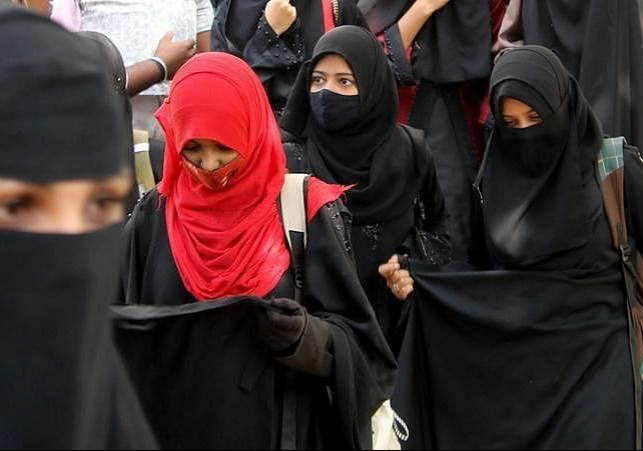

The BJP's distance from the MP education minister's remarks on a "uniform dress code," as well as the Karnataka government's suggestion of reconsideration on its school uniform policy, come amid rising uneasiness among the BJP leadership over how the "hijab row" is playing out.
According to sources, there is a belief that the Karnataka government and the state BJP encouraged protests in Udupi by a "small group of students at various pre-university institutes" to develop, reach the high court, and take on a national scale.
Images and videos of young ladies entering to class with a crowd of protesting males behind them, schoolgirls and even teachers being made to remove their headscarves, and some being requested to leave the school gates have added to the uneasiness among a portion of the leadership.
The Union Minister said, “This comes at a time when we play up Beti Bachao, Beti Padhao, when the PM highlights his government’s triple talaq ban as a step for empowering Muslim women.”
Senior BJP leaders in Delhi have refused to comment on the matter. When the Opposition raised the issue in the Lok Sabha, few BJP MPs spoke up, with the exception of Kolar's S Muniswamy. Even Tejasvi Surya, who has a history of provocative remarks, has remained silent.
The education minister in Tripura expressed worry, but Chief Minister Nitish Kumar of the NDA-ruled state of Bihar stated that the hijab was not an issue in Bihar because religious views were respected. Govind Singh Thakur, the education minister in BJP-ruled Himachal Pradesh, claimed that no active consideration of a uniform clothing code in schools has been made so far.
Another BJP leader expressed concern that the matter may erupt into a riot, similar to the anti-CAA riots, which also included Muslim women at the forefront. “Despite its initial enthusiasm and propaganda over the CAA, the government has not yet made rules for the law passed in December 2019,” the leader noted.
According to sources, there is one more significant distinction. This is considered as directly tied to faith and family, unlike the CAA, which is simply a law. When more Muslim females are attending schools and colleges than ever before, a code like this could have an impact, according to one leader.
According to sources, there is one more significant distinction. This is considered as directly tied to faith and family, unlike the CAA, which is simply a law. When more Muslim females are attending schools and colleges than ever before, a code like this could have an impact, according to one leader.
The minister went on to say that many options for resolving the Karnataka issue have been examined. “There have been suggestions that the state take the stand that girls could use the dupattas that are a part of the uniform to cover their heads. The leadership seems to be keen on finding a middle path instead of being seen as hardliners on this,” the minister said.
A party leader says, “Delhi (the national leadership of the BJP) doesn’t like it when a state creates controversy, lets it flare up and then throws it into the lap of the national leadership to resolve.”
According to a source in Delhi, the hijab row in Karnataka was "a spark that could have been put off, instead of letting it to kindle."
“What did they do to douse the fire? They were not even present to defend the government,” said a leader. Bommai, whose position within the faction-ridden BJP is shaky, does not have much command over the party cadre, the leader pointed out. “But finally it was he who told them to not fan the fires.”Those close to Karnataka Chief Minister Basavaraj Bommai argue that blaming him is unfair and that the blame should be placed on the party's state branch.
Both Chief Minister Shivraj Singh Chouhan and his hardline Home Minister Narottam Mishra in Madhya Pradesh distanced themselves from Education Minister Inder Singh Parmar's remarks about a uniform clothing code. While Chouhan is claimed to have summoned ministers to a Cabinet meeting and instructed them not to speak out without first contacting the government, Parmar later stated that no plan for a uniform code was in the works.
Mishra expressed his displeasure with right-wing extremists harassing two hijab-wearing women on a college campus in Datia, his hometown, and constituency. Mishra described the town as a live example of "communal harmony," and urged the district collector to investigate why the institution had issued an order prohibiting religious clothing.
A senior party leader who is also an office-bearer revealed that the higher leadership had told him not to bring up the hijab issue. “It was never a BJP issue, the party never wanted to create this issue. It’s a local fight,” the leader explained. Another MP from Madhya Pradesh's ruling party verified the stay-away order.
In an apparent 180-degree change from Parmar's earlier words, BJP state media in-charge Lokendra Parashar now believes ladies should choose what they wish to wear: "it is their issue."
He said, “The dress code is already in place. We just want to empower the women so that they can make an independent decision on whether they should or should not wear a hijab… School is not a place where religion should be a point of discussion, schools are to impart education, and that alone.”